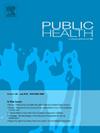1990 - 2021年哮喘流行病学及其归因危险因素:基于2021年全球疾病负担研究和孟德尔随机化研究的系统分析
IF 3.9
3区 医学
Q1 PUBLIC, ENVIRONMENTAL & OCCUPATIONAL HEALTH
引用次数: 0
摘要
目的哮喘是由下呼吸道慢性炎症引起的常见病。本研究旨在评估1990年至2021年全球哮喘负担以及特定危险因素导致的死亡率趋势。研究设计基于2021年全球疾病负担研究和孟德尔随机化研究的系统分析。方法基于1990年至2021年的全球哮喘量表,我们进行了二次分析,以探讨发病率、死亡率、残疾调整生命年(DALYs)以及哮喘的危险因素。采用孟德尔随机化(MR)分析来验证结果。结果2021年,全球共有41,555,628例哮喘病例。从1990年到2021年,哮喘病例减少了0.09%(95%不确定区间[UI]: 0.12,0.06)。在过去三十年中,与哮喘相关的死亡人数从374,377人(95%死亡率:304,600-492,653)增加到436,192人(95%死亡率:357,795-555,604)。全球发病率从每10万人736.99人(95% UI: 615.03-905.18)下降到516.70人(95% UI: 425.36-646.13);哮喘相关死亡率从每10万人9.64人(95%死亡率:7.76-12.80)降至5.20人(95%死亡率:4.27-6.59)。按年龄划分的发病率和流行率在9岁以下的个体中达到高峰。在社会人口指数(SDI)较高的国家,个体的哮喘患病率和发病率相对较高;然而,哮喘患者的死亡率和DALYs率呈现相反的趋势。在全球范围内,职业哮喘、体重指数、吸烟和空气污染是2021年哮喘相关死亡率和伤残调整生命年的主要危险因素。磁共振分析进一步证实了体质指数、职业性哮喘和哮喘之间的强相关性。结论:尽管从1990年到2021年,哮喘总发病率略有下降,但哮喘在全球范围内仍继续构成威胁生命的负担。一般来说,哮喘多发生在较年轻的年龄,在高sdi国家更为普遍,这表明存在特定的周期性和区域性特征。提高对哮喘流行病学的了解可以促进未来的干预措施,以更好地在全球范围内管理该病,并支持未来对哮喘诊断和治疗的调查。本文章由计算机程序翻译,如有差异,请以英文原文为准。
The epidemiology of asthma and its attributable risk factors from 1990 to 2021: A systematic analysis based on the Global Burden of Disease Study 2021 and Mendelian Randomization Studies
Objectives
Asthma is a commonly occurring condition due to chronic inflammation of the lower respiratory tract. This study aims to assess the global burden of asthma from 1990 to 2021 and the mortality trends caused by specific risk factors.
Study design
Systematic analysis based on the Global Burden of Disease Study 2021 and Mendelian Randomization studies.
Methods
Based on a global asthma scale spanning from 1990 to 2021, we performed a secondary analysis to explore the incidence, mortality, and disability-adjusted life-years (DALYs), along with risk factors for asthma. Mendelian randomization (MR) analyses were performed to verify the results.
Results
In 2021, there were 41,555,628 incident cases of asthma worldwide. Cases of asthma decreased by 0.09 % (95 % uncertainty interval [UI]: 0.12,0.06) from 1990 to 2021. Over the past three decades, asthma-associated deaths increased from 374,377 (95 % UI: 304,600–492,653) to 436,192 (95 % UI: 357,795–555,604). The global incidence rate decreased from 736.99 (95 % UI: 615.03–905.18) to 516.70 (95 % UI: 425.36–646.13) per 100,000 population; the asthma-associated mortality rate decreased from 9.64 (95 % UI: 7.76–12.80) to 5.20 (95 % UI: 4.27–6.59) per 100,000 population. Age-specific incidence and prevalence rates peaked in individuals under nine years old. The prevalence and incidence rates of asthma were relatively higher in individuals in countries with higher Socio-demographic Index (SDI); however, mortality and DALYs rates of individuals with asthma showed a reverse trend. Globally, occupational asthmagens, body mass index, smoking, and air pollution were key risk factors for asthma-associated mortality and DALYs in 2021. MR analyses further confirmed the strongly related correlation between body mass index, occupational asthmagens and asthma.
Conclusions
Although a mild decrease in total incidence cases of asthma was observed from 1990 to 2021, asthma has still continued to pose a life-threatening burden worldwide overall. Generally, asthma frequently occurred at younger ages and is more prevalent in high-SDI countries, indicating that specific periodic and regional features exist. Improved understanding of the epidemiology of asthma could facilitate future interventions to better manage the disease globally and support future investigation on the diagnosis and treatment of asthma.
求助全文
通过发布文献求助,成功后即可免费获取论文全文。
去求助
来源期刊

Public Health
医学-公共卫生、环境卫生与职业卫生
CiteScore
7.60
自引率
0.00%
发文量
280
审稿时长
37 days
期刊介绍:
Public Health is an international, multidisciplinary peer-reviewed journal. It publishes original papers, reviews and short reports on all aspects of the science, philosophy, and practice of public health.
 求助内容:
求助内容: 应助结果提醒方式:
应助结果提醒方式:


